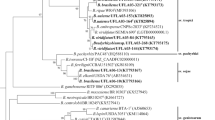Abstract
Two strains (RCR 1001 and 1044) and a commercial inoculant (Okadin) ofRhizobium leguminosarum biovarviceae were tested for their ability to survive in autoclaved clay soil for up to four months under heat, salinity and drought stress. Resistance to heat was tested by incubating rhizobia in soil at 27, 37 and 42 °C. Tolerance of rhizobia to salinity was investigated by growing rhizobia in soil salinized with 1 and 2 % NaCl (m/m). Drought resistance was tested by subjecting bacteria to soil moisture contents of 20, 10 and 5%. Strain RCR 1001 was more resistant to heat and nodulated faba bean better than other tested strains. A commercial inoculant Okadin survived more (plate count method) and nodulated faba bean (plant infectivity, most probable number, MPN) at moisture content of 5% and 2% NaCl. Although, strains RCR 1001 and 1044 resisted these stress conditions (plate count) they lost their abilities to nodulate faba bean (MPN-test). There is a possibility for selection of effective rhizobia which are more tolerant to harsh conditions.
Similar content being viewed by others
References
Abd-Alla, M.H.: Nodulation and nitrogen fixation in faba bean (Vicia faba L.) plants under salt stress.—Symbiosis12: 311–319, 1992.
Abdel Wahab, A.M., Zahran, H.H.: Salt tolerance ofRhizobium species in broth cultures.—Z. allg. Mikrobiol.19: 681–685, 1979.
Al-Rashidi, R.K., Loynachan, T.E., Frederick, T.R.: Desiccation tolerance of four strains ofRhizobium japonicum.—Soil Biol. Biochem.14: 489–493, 1982.
Baldani, J.I., Weaver, R.W.: Survival of clover rhizobia and their plasmid-cured derivatives in soil under heat and drought stress.—Soil Biol. Biochem.24: 737–742, 1992.
Bowen, G.D., Kennedy, M.M.: Effect of high soil temperatures onRhizobium spp.—Queensland J. agr. Sci.18: 177–196, 1956.
Bushby, H.V.A.: Ecology.—In: Broughton, W.J. (ed.): Nitrogen Fixation. Volume 2:Rhizobium Pp. 35–75. Clarendon Press, Oxford 1982.
Busse, M.D., Bottomley, P.J.: Growth and nodulation response ofRhizobium meliloti to water stress induced by permeating and non permeating solutes.—Appl. environ. Microbiol.55: 2431–2463, 1989.
Chao, W.L., Alexander, M.: Influence of soil characteristics on the survival ofRhizobium in soils undergoing drying.—Soil Sci. Soc. Amer. J.46: 949–952, 1982.
Eaglesham, A.R.J., Ayanaba, A.: Tropical stress ecology of rhizobia, root nodulation and legume nitrogen fixation.—In: Subba Rao, N.S. (ed.): Current Development in Biological Nitrogen Fixation. Pp. 1–35. Edward Arnold Ltd., London 1984.
Elsheikh, E.A.E., Wood, M.: Salt effects on survival and multiplication of chickpea and soybean rhizobia.—Soil Biol. Biochem.22: 343–347, 1990.
Foulds, W: Effect of drought on three species ofRhizobium.—Plant Soil5: 665–667, 1971
Fuhrmann, J., Davery, C.B., Wollum, A.G. II: Desiccation tolerance of clover rhizobia in sterile soils. —Soil Sci. Soc. Amer. J.50: 639–644, 1986.
Gewaily, E.M., Khan, M.F., Kheder, A.K.: Effect of temperature and calcium carbonate contents of soil on the survival and growth of rhizobia.—In: 13th North American Symbiotic Nitrogen Fixation Conference. P. 50. Banff Centre for Conferences, Canada 1991.
Graham, P.H.: Stress tolerance inRhizobium and nodulation under adverse soil conditions.—In: 13th North American Symbiotic Nitrogen Fixation Conference (Abstract). In: 13th North American Symbiotic Nitrogen Fixation Conference. P. 30. Banff Centre for Conferences, Canada 1991.
Mahler, R.L., Wollum, A.G. II: The influence of water potential and soil texture on the survival ofRhizobium japonicum andRhizobium leguminosarum isolates in the soil.—Soil Sci. Soc. Amer. J.45: 761–766, 1981.
Munevar, F., Wollum, A.G. II: Growth ofRhizobium japonicum strains at temperatures above 27°C. —Appl. environ. Microbiol.35: 422–430, 1981.
Pena-Cabriales, J.J., Alexander, M.: Survival ofRhizobium in soils undergoing drying.—Soil Sci. Soc. Amer. J.43: 962–966, 1979.
Pillai, S.D., Pepper, I.L.: Survival of Tn5 mutant bean rhizobia in desert soils: Phenotypic expression of Tn5 under moisture stress.—Soil Biol. Biochem.22: 265–270, 1990.
Salema, M.P., Parker, C.A., Kidby, D.K., Chatel, D.L., Armitage, T.M.: Rupture of nodule bacteria on drying and rehydration.—Soil Biol. Biochem.14: 15–22, 1982.
Sen, D., Baldani, J.I., Weaver, R.W.: Expression of heat induced proteins in wild type and plasmid-cured derivatives ofRhizobium leguminosarum bv.trifolii.—In: Gresshoff, P.M., Roth, L.E., Stacey, G., Newton, W.E. (ed.): Nitrogen Fixation Achievements and Objectives. Pp. 200–201. Chapman and Hall, London 1990.
Shoushasi, N.M., Pepper, I.L.: Mesquite rhizobia isolated from the Sonoran desert: Competitiveness and survival in soil.—Soil Biol. Biochem.17: 803–806, 1985.
Singleton, P.M., Elswaify S.A., Bohlool, B.B.: Effect of salinity onRhizobium growth and survival. —Appl. environ. Microbiol.44: 884–890, 1982.
Somasegaran, P., Hoben, H.J.: Methods in Legume-Rhizobium Technology.—NifTAL Project and MIRCEN, University of Hawaii, Paia 1985.
Sprent, J.I., Sprent, P.: Nitrogen Fixation Organisms: Pure and Applied Aspects.—Chapman and Hall, London 1990.
Toomsan, B., Rupela, O.P., Mittel, S., Dart, P.J., Clark, K.W.: Counting cicer-Rhizobium using a plant infection technique.—Soil. Biol. Biochem.6: 503–507, 1985.
Weaver, R.W., Holt, E.C.: Short-term survival of rhizobia on arrow leaf clover seed at different depths.—Plant Soil122: 147–150, 1990.
Weaver, R.W., Materon, L.A., Krautmann, M.E., Rouquette, F.M.: Survival ofRhizobium trifolii in soil following inoculation of arrow leaf clover.—Mircen J. appl. Microbiol. Biotechnol.1: 313–318, 1985.
Zahran, H.H.: Cultural and physiological properties of some root-nodule bacteria indigenous in the salt-affected soils of Egypt.—Bull. Fac. Sci., Assiut Univ.20: 85–100, 1991.
Zahran, H.H., Lindstrom, K.: Lipopolysaccharide and protein patterns of rhizobia isolated from arid and salt-affected lands of Egypt and Sudan.—In: Gresshoff, P.M., Roth, L.E., Stacey, G., Newton W.E. (ed.) Nitrogen Fixation Achievements and Objectives. Pp. 200–201. Chapman and Hall, London 1990.
Author information
Authors and Affiliations
Rights and permissions
About this article
Cite this article
Abd-Alla, M.H., Wahab, A.M.A. Survival ofRhizobium leguminosarum biovarviceae subjected to heat, drought and salinity in soil. Biol Plant 37, 131–137 (1995). https://doi.org/10.1007/BF02913008
Received:
Accepted:
Issue Date:
DOI: https://doi.org/10.1007/BF02913008




